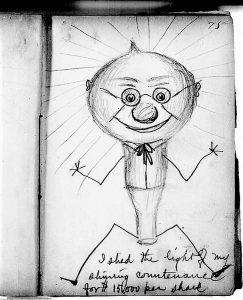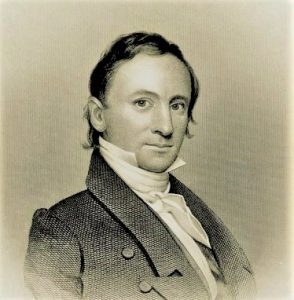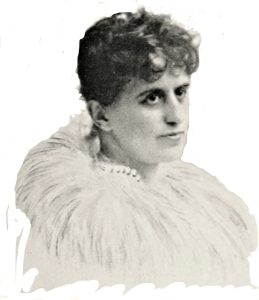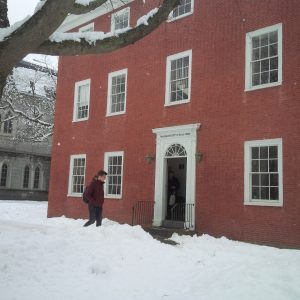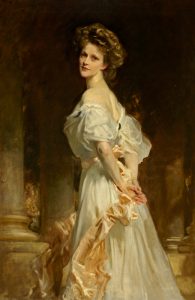Like China, Americans were notorious for cultural piracy and weak copyrights. The U.S. finally acknowledged international copyrights when the balance of trade in cultural goods shifted in their favour. Similarly, China today is strongly enforcing copyrights to protect its emerging global leadership in cultural creativity.
Economics of/for The Common Good
Thomas Edison and the Bowdoin Inventors
Who invented the light bulb? Isaac Adams Jr., Bowdoin class of 1858, created an incandescent light bulb with a carbon filament 14 years before Thomas Edison. However, he failed to persevere and produce a scalable innovation that would benefit consumers in the market. Instead, two highly-educated mathematical scientists from the class of 1875, Francis Upton and Charles Clarke, provided invaluable systematic research at Edison’s lab in Menlo Park. As such, without the contributions of Bowdoin inventors, the discovery and diffusion of electrical lighting would have been significantly retarded.
Who was the First U.S. Economics Professor? Samuel Newman, of Bowdoin College
Prof. Samuel P. Newman (appointment in Political Economy, 1824-1839). Samuel Phillips Newman and Bowdoin Economics In 1824, Bowdoin was the first American College to officially introduce a faculty position dedicated to instruction in Economics (or Political Economy, as it was then known). The University of Virginia in 1826, and Brown University in 1828, followed Bowdoin, […]
Old School? Apprenticeships in the 21st Century
The word apprentice conjures up visions of sorcerers and medieval guilds (and, in my case, my great-grandmother who learned the goldsmith’s trade through a family apprenticeship). However, “new collar” apprenticeships seem destined to become the most effective means of human-capital acquisition for the twenty first century, as they have been for millenia.
Is Technology a Race? Patents and National Security
Metaphors matter. Is technology a race, or a war with an associated D-day? References to “the race to 5G” and “innovation wars” are based on a zero-sum model of technological innovation, where there are glorious outcomes for “winners” and dire consequences for “losers.” According to this ahistorical perspective, the leader takes all, and for the rest of the field, life promises to be poor, nasty, brutish, and short. In order to avoid this doomsday scenario, previously unthinkable measures become acceptable in the name of “national security.”
Notable Women Inventors of Maine
The surge of new inventions and innovations in nineteenth century America transformed the world to an extent that arguably remains unmatched today. Even among the New England states known for their “Yankee ingenuity,” Maine inventors surpassed their peers. Among the few female entries in the National Inventors Hall of Fame are Helen Blanchard and Margaret Knight, celebrated because of their successful industrial machines. But the typical woman inventor productively directed their attention to supposedly minor “feminine inventions” like dress charts and kitchen tools that improved the lives of other women and their families.
Back to School for the “Spring” Semester (1861)
How many aspects of life at Bowdoin College have remained unchanged since the days when faculty, president, and students all lived in Mass Hall? In January 2022, we can still fervently empathize with this account of the “spring” semester in the Journal of John Deering, Jr., class of 1864: “Find myself back to this honored institution after an absence of nine weeks… Nothing can be seen except a boundless expanse of snow… But after all, I suppose I can pursue my studies and carry out the objects for which I was sent just as well as if the grass were green and the birds singing.”
Looking Backward: From 5G to the Telegraph
The advent of 5G cellular technology has induced imaginative speculations about spectacular virtual universes, Humans 3.5 artificial intelligence, and an Internet of Things that will trigger “smart houses” and even smarter cities. What lessons can earlier telecommunications inventions offer? The focus here is on five issues regarding 5G: the social savings from new innovations; business to business (B2B) relative to consumer markets; private sector versus government-led initiatives; net neutrality; and the right to privacy.
Women and Wealth in the New Gilded Age
Are we currently living in a new Gilded Age embodied by the multi-billionaires of the Forbes 400, with their excesses of utopian cities and space tourism? Inclusion on The Forbes 400 list for 2021 requires net worth of at least $2.9 billion. However, these data underestimate women’s achievements, and conceal an underlying pattern of increasing entrepreneurial opportunities, socioeconomic mobility, and philanthropy by “robber baronesses.”
Women and Innovation in Developing Countries
Round table discussion of gender, patents, open source, and technology policy in India. Participants include Zorina Khan (the moderator) and leading Indian academics, patentees, entrepreneurs, and innovators.

